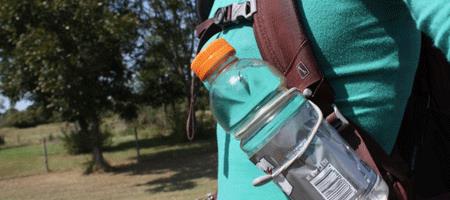Save 25% On Your First Autoship Order
Save 25% On Your First Autoship Order

Traveling with an ostomy can sometimes be a tedious task since one has to take care of a lot of things that might go wrong or cause problems during the travel. Leakages, odors, shortage of supplies, etc. can be very harrowing for a person during the travel. Hence it is always recommended to ensure a few things before you depart on a journey. We have listed a few below:
Always carry extra supplies. Never plan on buying them where you intend to travel to since there is a possibility you might not find them there. Hence it is always better to carry all the extra things like pouches, pads, barriers, etc. with you during the journey. You can also carry a pair of scissors along with you given that you have taken the needed clearance for doing so. You can carry them in your checked-in luggage but not all countries and states allow carrying them in your carry on luggage.In domestic flights within the United States, you are allowed to carry scissors in your carry-on luggage, as long as the cutting edge is shorter than 4 inches. Initially, after Sept 11, 2001, pointed metal scissors were banned from carry-on luggage worldwide. In the U.S., the Transportation Security Administration (TSA) declared in December 2005 that scissors with cutting edges up to 4 inches are allowed.

Meanwhile, if you travel outside the U.S., you may face more severe restrictions on carrying scissors. Some countries allow regulated sized scissors while other countries may prohibit scissors in carry-on entirely. So, if you’re traveling internationally, unless you’re sure of the rules in the countries you’ll be flying through, it’s best to avoid scissors in your carry-on (you can always pack scissors in your checked luggage).
TSA has a service that allows passengers with disabilities or ostomies to avail passenger support during the flight given that they contact the TSA contact center, 72 hours before the flight. Different airports have different services and hence this can vary from city to city.

If you are traveling by bus, train, or an airplane, arrive early at the departure point so that you know what to do next and have enough time on hand if something goes wrong. Security and screening processes take time and it is always best if it is done calmly and efficiently.

One cannot change their pouching in public and hence it is important to find a suitable bathroom or changing room where you can easily remove the previous pouching and fit a new one. You should also take care about disposing off the old pouching properly.

Ostomy belts are a great add on while traveling as they help support the ostomy and the pouch with ease. A stoma guard adds on can help protect your stoma from sudden jerks or any kind of sudden motion in that case. Protecting the stoma and the pouching system is of utmost importance.

Places with warm or hot climates tend to increase the perspiration rate and hence might create problems for your ostomy. Skin irritation under the flange or the barrier can be a common occurrence during this time. Hence using an antiperspirant cream can help reduce moisture in the ostomate region. Cold climates might cause the skin to harden and dry up hence increasing chances of rashes so it is better to carry a moisturizer with you. Consult a specialist before using any cream or lotion.

One must be very careful while using non-potable water while traveling as it can conclude with diarrhea. If clean water is not available in the region then use bottled water to irrigate the ostomy to be safe from any infections or complications.

According to the rules, items such as liquids, gels or aerosols must be carried in containers smaller than 100 mL (3.4 ounces), and you can carry only as many of these as fit comfortably into a single one-quart (one-liter) zip-top clear plastic bag. These rules are generally enforced worldwide. The most important ostomy supplies, such as pouches and barriers, are not liquids, gels or aerosols, so as they aren’t subject to these rules you can carry as many as you want in your carry-on. But some related ostomy products do fall into the liquid-gel-aerosol category. If you need to carry a few of these on the airplane, it’s usually easy to fit them into your zip-top plastic bag to comply with rules. If you need more of them, you can pack as many as you want in your checked luggage. Larger quantities of liquids-gels-aerosols that are medically necessary and must be carried on board the plane are allowable but must be declared at the security checkpoint and require additional screening.

Summed up, an ostomy should not be something that adds stress to your travels. We hope the information provided in this article helps you to prepare so you can enjoy stress-free travel!
Disclaimer: All content found on our website, including images, videos, infographics and text were created solely for informational purposes. Our content should never be used for the purpose of diagnosis or treatment of any medical conditions. Content shared on our websites is not meant to be used as a substitute for advice from a certified medical professional. Reliance on the information provided on our website as a basis for patient treatment is solely at your own risk. We urge all our customers to always consult a physician or a certified medical professional before trying or using a new medical product.

Taikhum Sadiq has been a Health Products For You contributor since 2016.
He is an archaeology student and is passionate about learning about the past and how it impacts our future. He believes ...
How To Increase Iron Levels Quickly
It’s a question that must have puzzled you like many others. Iron is essential in hemoglobin production and its inadequate levels can negatively impact your health. Dive into this informative article to explore top iron-rich foods that can help you fight iron deficiency.
10 Best Coccyx Cushions for Tailbone Pain
If you're like most people, you spend about 8 to 10 hours sitting every day. However unhealthy, it is part of life for many, and can cause tailbone pain. Coccyx cushions can help alleviate this pain. Click to read more and find the perfect coccyx cushion for your tailbone pain.
5+ Best Adult Diapers for Fecal Incontinence
Dealing with fecal incontinence can be challenging, but you're not alone. Read this article and navigate through discreet and effective solutions that help you manage fecal incontinence and let you live life on your terms with confidence and comfort.
Top 5 Best Reviewed Nebulizers of 2024
Need an effective and affordable nebulizer? Look no further, in this article we offer 5 of our best reviewed nebulizers that are loved by our customers. Click to read more and find the perfect nebulizer for all your respiratory needs.
10 Best Penis Pumps For Erectile Dysfunction
For anyone dealing with erectile dysfunction, penis pumps serve as a great way to manage it. But with so many products available, determining the best one for your needs can be challenging. To assist you in refining your choices and making an informed decision, here are our top 10 options, recognized for their effectiveness and safety.